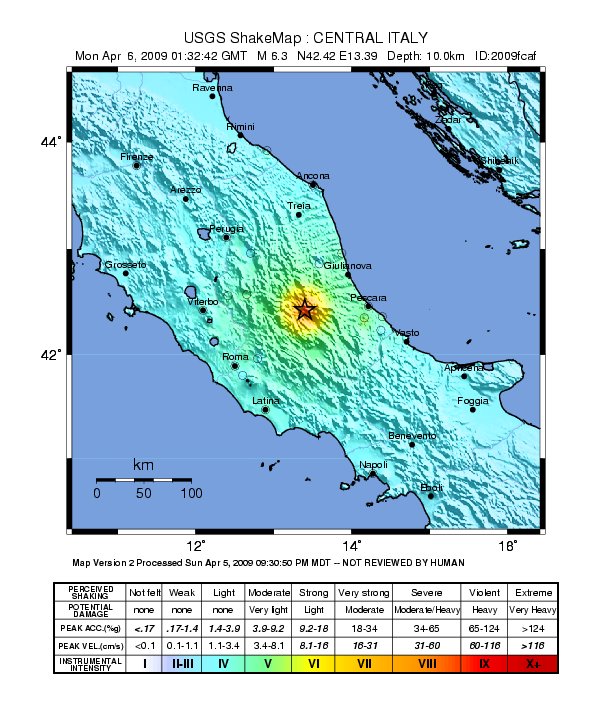On April 6, 2009, a 5.8 Richter magnitude earthquake struck the central Italian city of L’Aquila, killing 308 people, damaging several thousand buildings, and leaving some 65,000 people homeless. One month before, a local laboratory technician by the name of Giampaolo Giuliani predicted such a major quake on Italian television, citing increased levels of radon emission in the area. However, “he was accused of being alarmist by the Director of the Civil Defense and forced to remove his findings from the Internet. He was also reported to police a week before the main quake for ‘causing fear’ among the local population when he predicted that an earthquake was also imminent in the nearby city of Sulmona” (source).
But you can be damned if you do and damned if you don’t: “Six Italian seismologists and one government official will be tried for the manslaughter of those who died in an earthquake that struck the city of L’Aquila on 6 April 2009. The seven are accused of misinforming the population about seismic risk in the days before the earthquakes, indirectly causing the death of the citizens they had reassured. The case began in June 2010, when the public prosecutor of L’Aquila pressed manslaughter charges against the participants at a meeting of the Major Risks Committee (an expert group that advises the Italian Civil Protection), held on 31 March 2009.
At the time of the 31 March 2009 meeting, seismic activity had been going on in the area for more than three months, causing alarm in the population. De Bernardinis (then vice-president of Italy’s Civil Protection department, who in the meantime has become President of the Institute for Environmental Research and Protection) summoned the meeting and asked the scientists to assess the risk of a major earthquake and its possible consequences. The meeting was followed by a press conference by De Bernardinis and Barberi (a volcanologist at the University of Rome), where the two reassured the population that the seismic sequence did not necessarily hint at a major earthquake. De Bernardinis, in particular, appeared on television saying that ‘the scientific community tells me there is no danger, because there is an ongoing discharge of energy. The situation looks favorable.’ A major earthquake did hit on April 6 though, killing 309 people. In the aftermath, many citizens quoted those statements as the reason they did not take precautionary measures, such as fleeing their homes. According to the accusation, many people who would otherwise leave the area decided to stay, and were eventually killed in the collapse of their houses. After several delays due to procedural reasons, in the last few days the Public Prosecutor of L’Aquila Fabio Picuti and the seven defendants have finally appeared before Giuseppe Gargarella, a Judge at the Court of L’Aquila, who had to decide whether to dismiss the case or to proceed with the trial. After listening to both sides of the story, the judge accepted the prosecutor’s request to proceed with the case and decided that the trial will begin on 20 September” (source).
So where does such ambivalence leave Harold Camping who recently predicted that on May 21, 2011 Jesus would return, the righteous would fly up to heaven, and that there would follow five months of fire, brimstone, and plagues, with millions of people dying each day, culminating on Oct. 21, 2011 with the end of the world? Should his warnings have been censored for “causing fear”? And what if he’d been correct? Well, that’s a moot point. The real point is that earthquakes, like raptures (maybe–let’s see what happens on Oct. 21), are impossible to predict at present: “Neither the USGS nor Caltech nor any other scientists have ever predicted a major earthquake,” reads a statement posted on the USGS website. “They do not know how, and they do not expect to know how any time in the foreseeable future.”
Stupidity is an elemental force for which no earthquake is a match. Karl Kraus (1874-1936), one of the foremost German-language satirists of the 20th century

.jpg)


.jpg)
